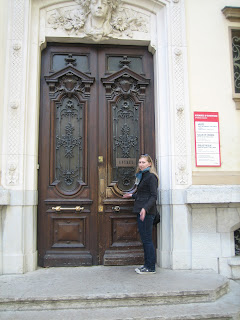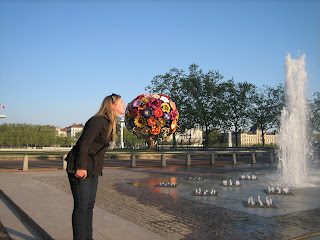While you mostly see pictures of Jeff and I in various states of leisure, there are certain practical reasons the University sent me to Paris. One of my goals while here was to learn more about the city and its history during the 19th century, a time when France in general and Paris in particular was a pretty crazy place to live. An event that's always been fascinating to both Jeff and me is the brief, four month period when Paris had its own revolution and formed its own socialist government.
This was right after the rather humiliating loss of the Franco-Prussian war and a very long, painful siege that left Parisians in bad shape. When the French army came in the middle of the night to get some canons that the Parisians had bought for the National Guard, on March 18, 1871, people in the working class areas of Montmartre weren't having it. Along with their local National Guardsmen, they chased the national army out of the city entirely.
We recently went to an exhibit of photos and other documents from the Commune at the Paris Hôtel de Ville. You can see some photos of the city under the Commune here.
This poster is calling for the construction of barricades to defend the city streets.
When Parisians have a revolution, they like to tear up the cobblestones and build giant walls out of them. That is the correct and traditional way to do it.
These posters publicized the new laws established by the Commune. Among them are the separation of church and state; free, universal and secular education; and the abolishment of night work for bakers. Some of these things later became French law under the Third Republic.
Unfortunately, things didn't go so well for the Commune. Internally, things were tough - the city was once again under siege, now by the national French forces. There was little money to pay soldiers or employees, and though they probably could have raided the Banque de France, they did not. Besides, not everyone was excited about the new government, and I imagine the formation of a Comité du Salut Public (Public Safety Committee) didn't reassure them - that's the same committee Robespierre lead during the Terror.
Long story short (here is a more detailed version, from a pro-Communard standpoint, for those interested), during the week of May 21-28, things turned ugly. The national army invaded the city with the help of some Prussian troops who were still hanging around. There were battles in the streets. Knowing they were about to be defeated, angry Communards decided if they couldn't have Paris, nobody could, and set fire to a number of major buildings, like the Hôtel de Ville, the Palais de Justice, the Palais des Tuileries, and the Palais Royal, among others.
A lot of the fires were blamed on working-class women called "Les Pétroleuses,"
later vilified in the press.
In order to put a definitive end to the Commune, the French government decided that all support for it was a serious crime, punishable by death or exile. Accordingly, they summarily executed many people believed to have fought for the Commune - sometimes this belief was based on light evidence, such as looking at a man's hands and deciding he might have shot a gun recently. People disagree about how many people were killed during la Semaine sanglante (the Bloody Week), but estimates range between 10 and 30,000.
A good number of them were shot against one of the walls of Père Lachaise cemetery. There is now a sculpture and a monument on either side of this wall, commemorating the people who fought and died in Paris's 1871 Revolution.
So while many people may think Paris is about luxury goods, or "who can doubt that Paris is a woman?", or la vie de bohème or whatever, and it is all those things (except a woman), but it's good to remember it's also a battleground.




























































